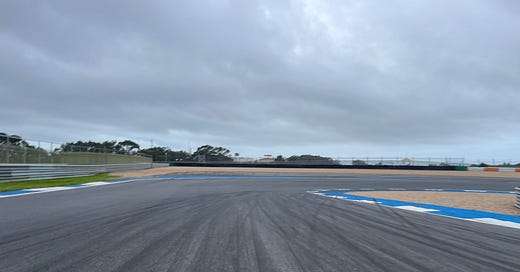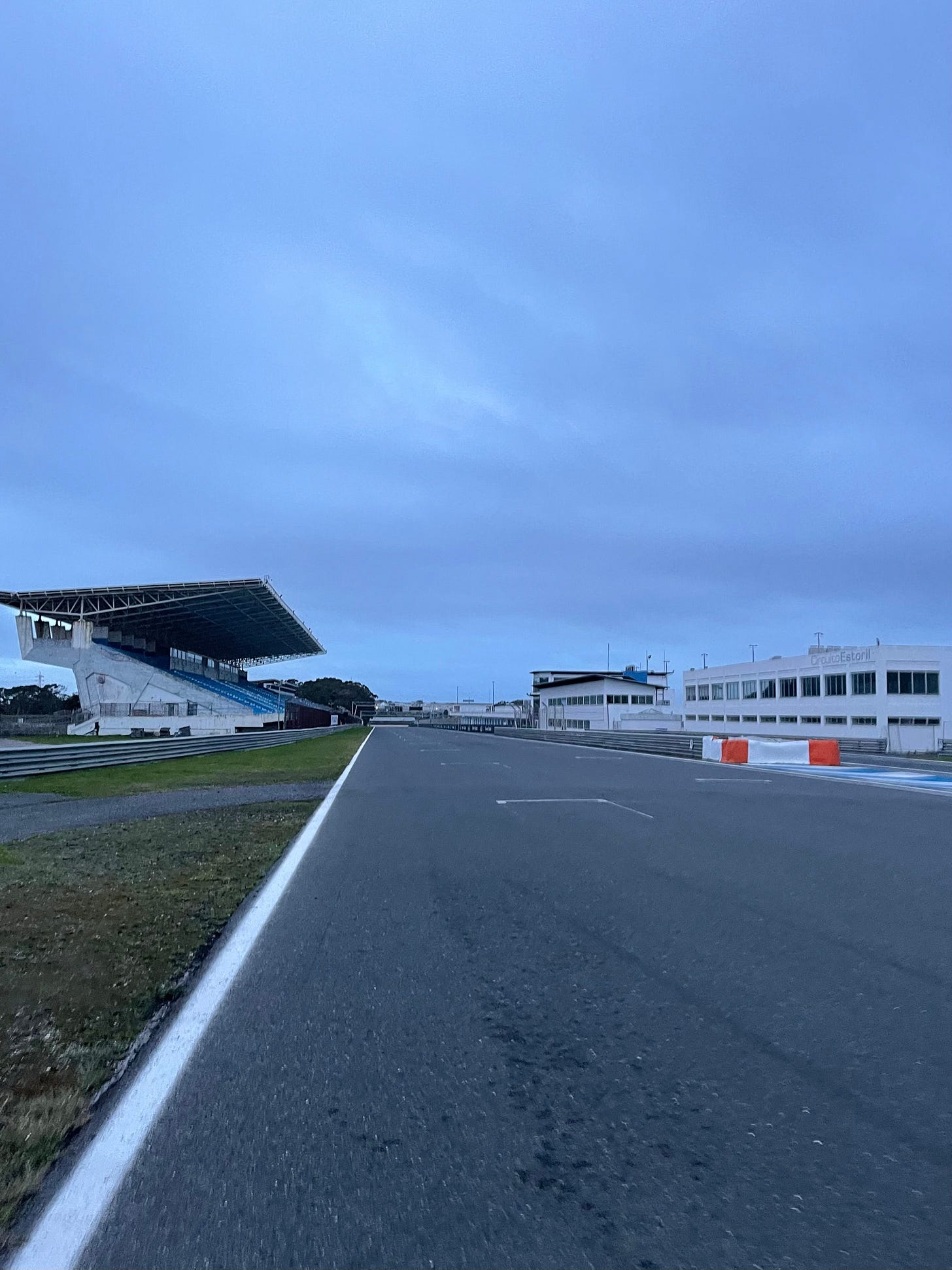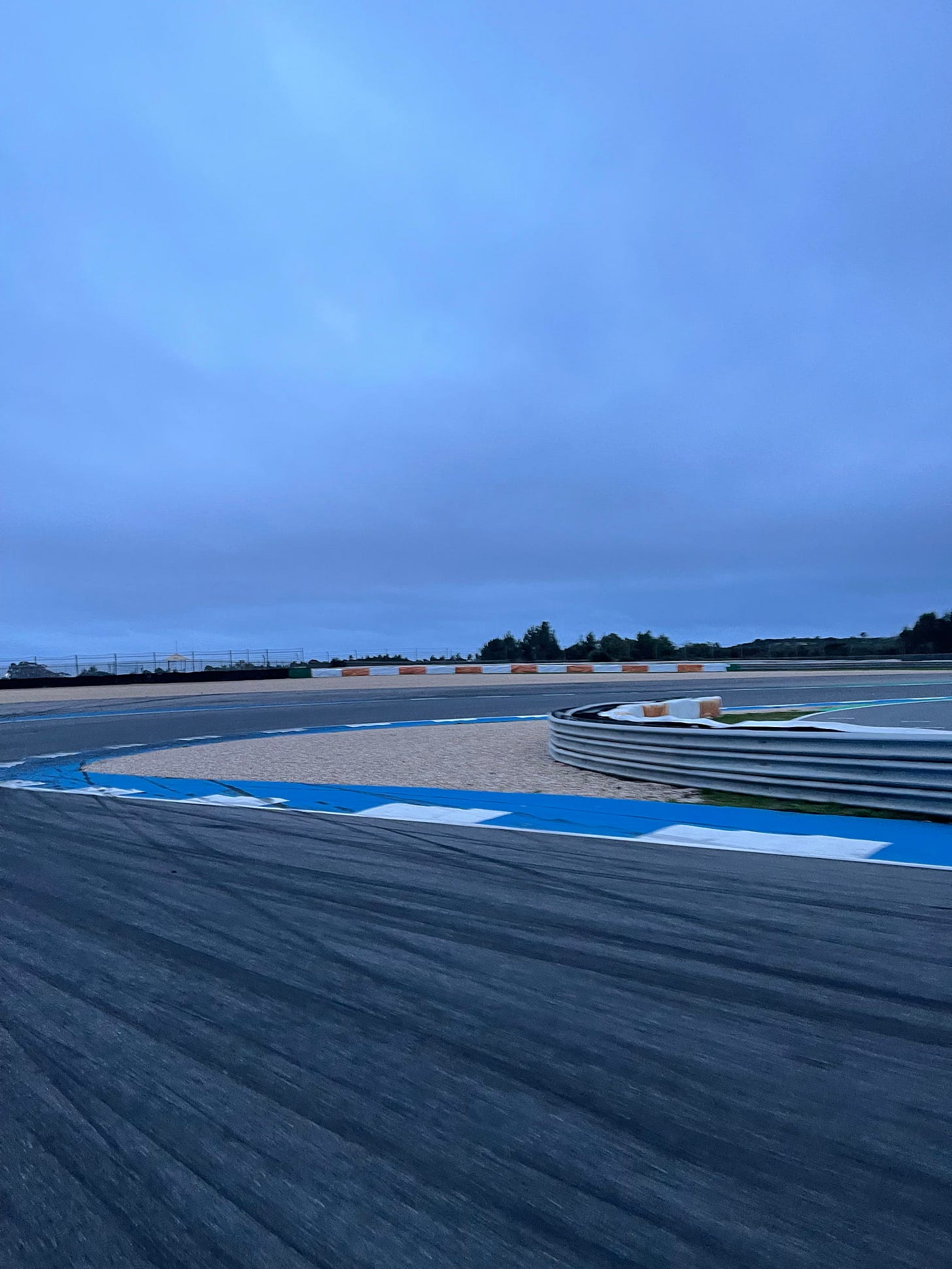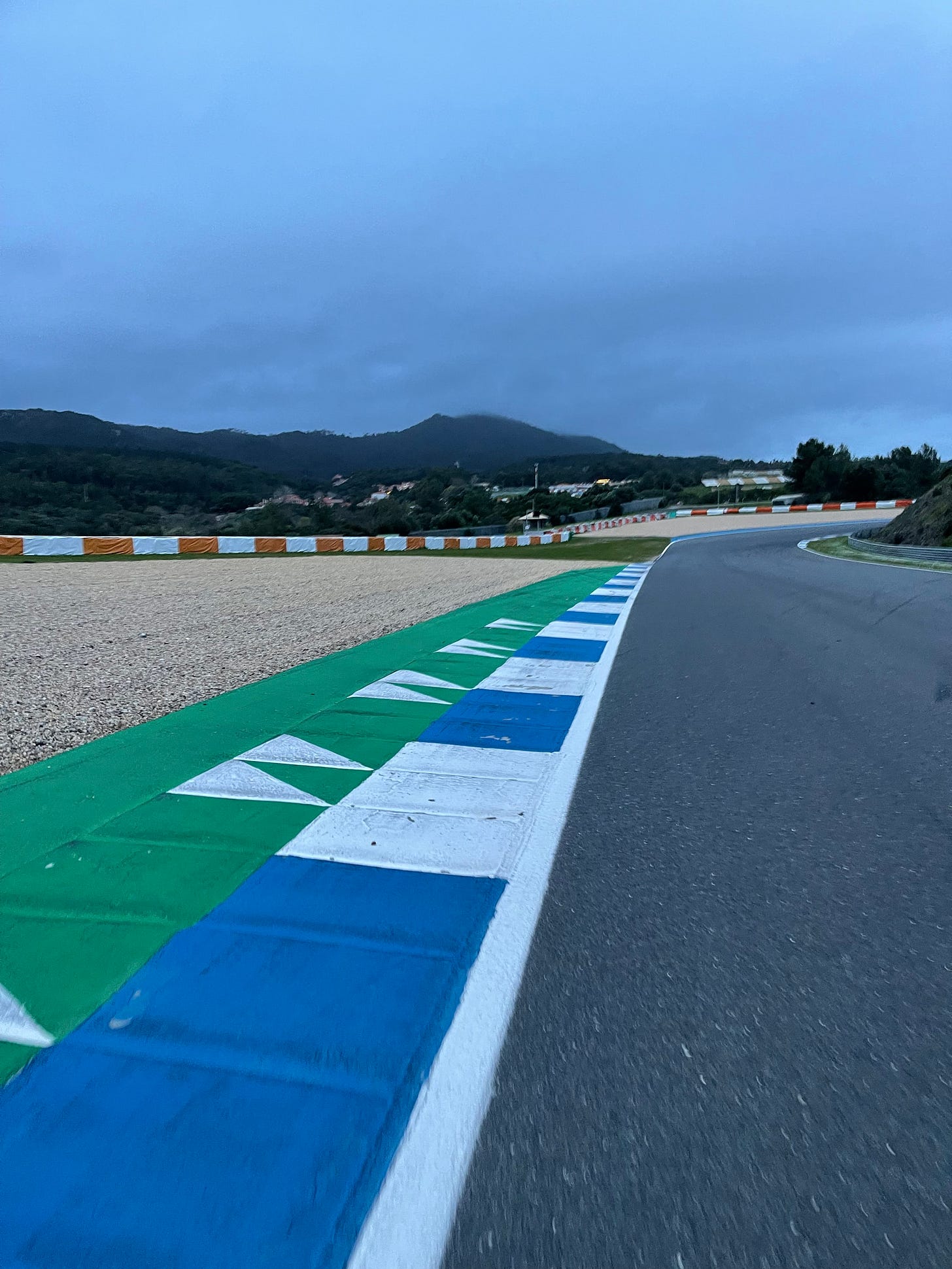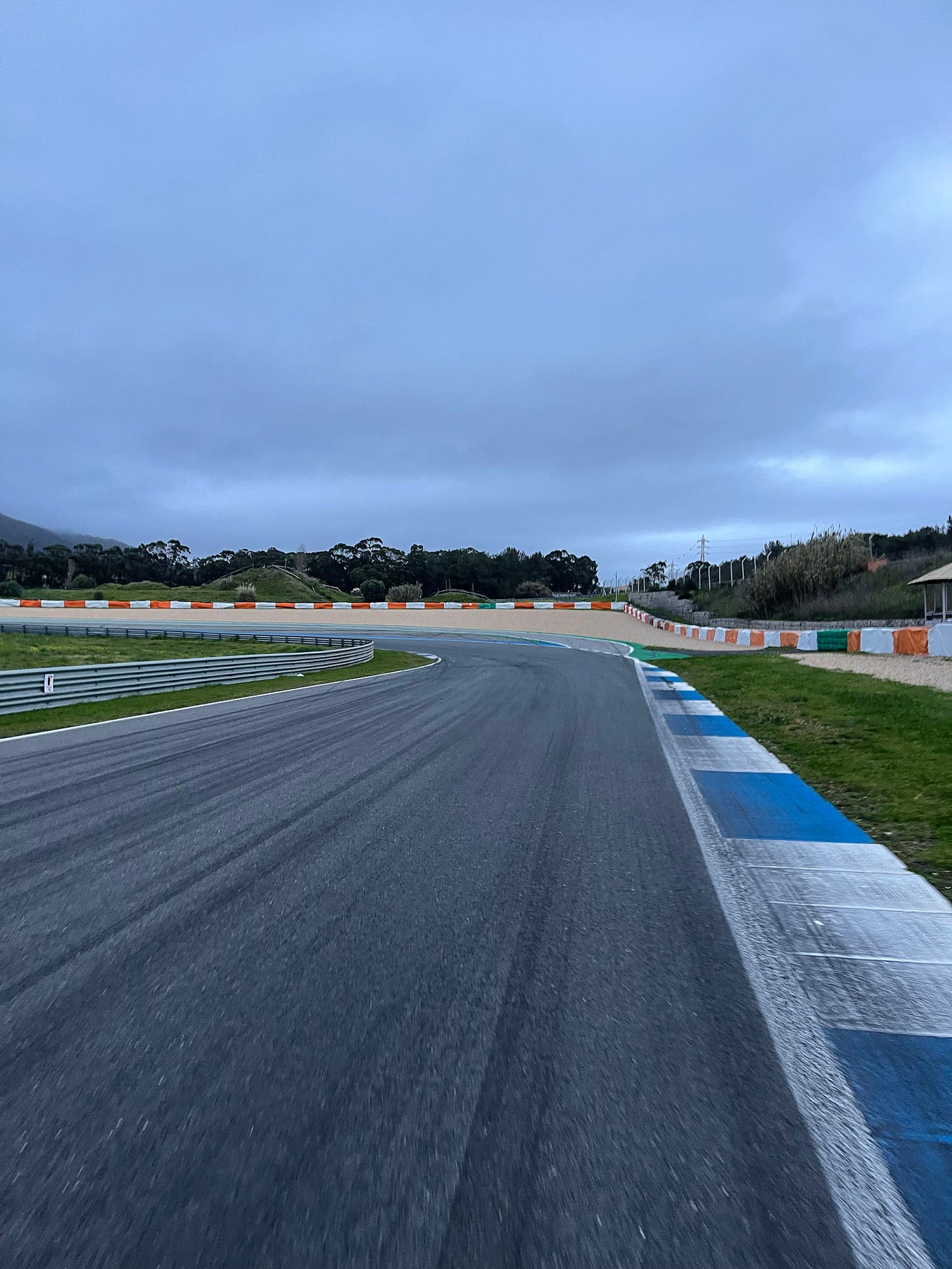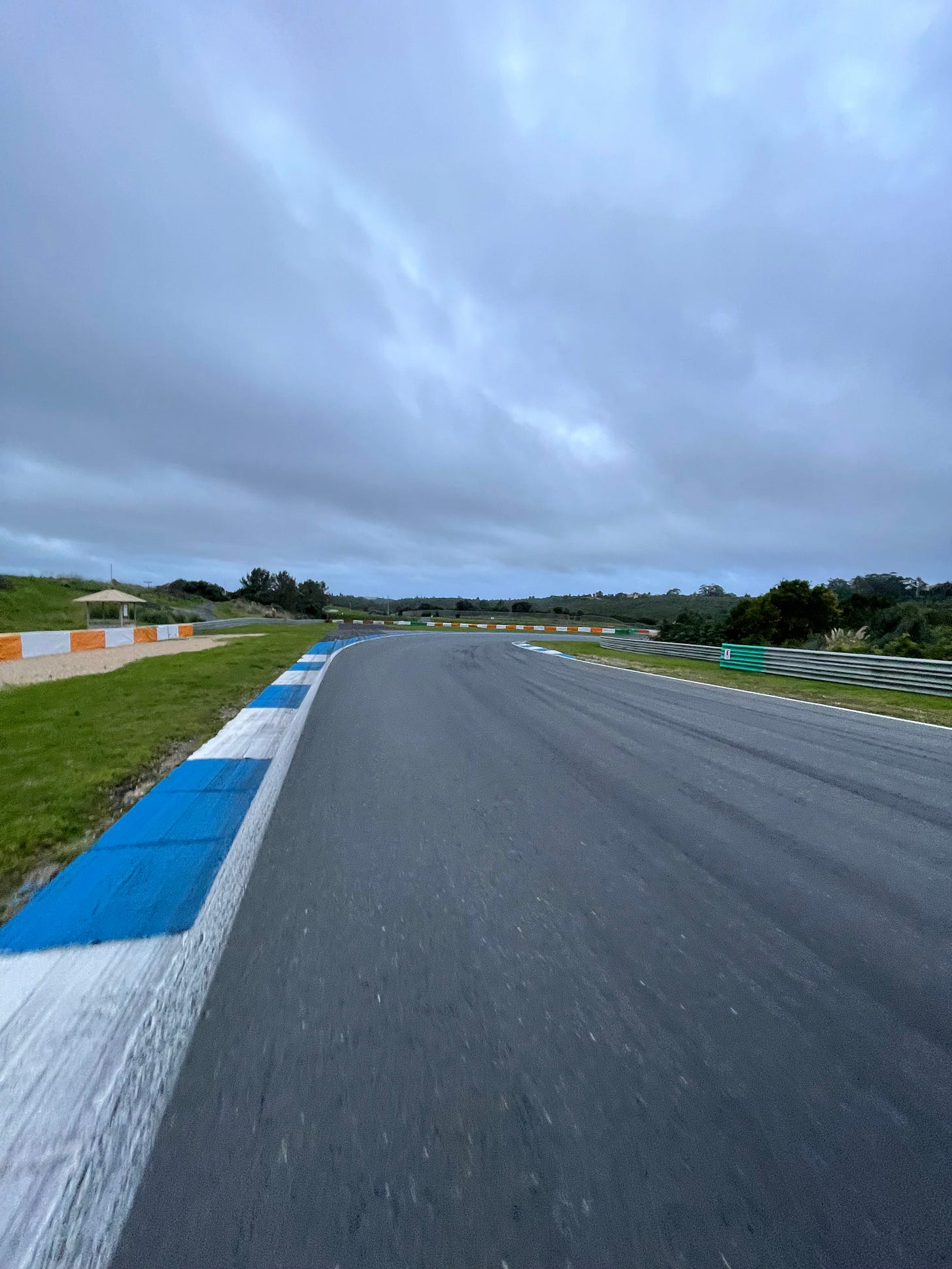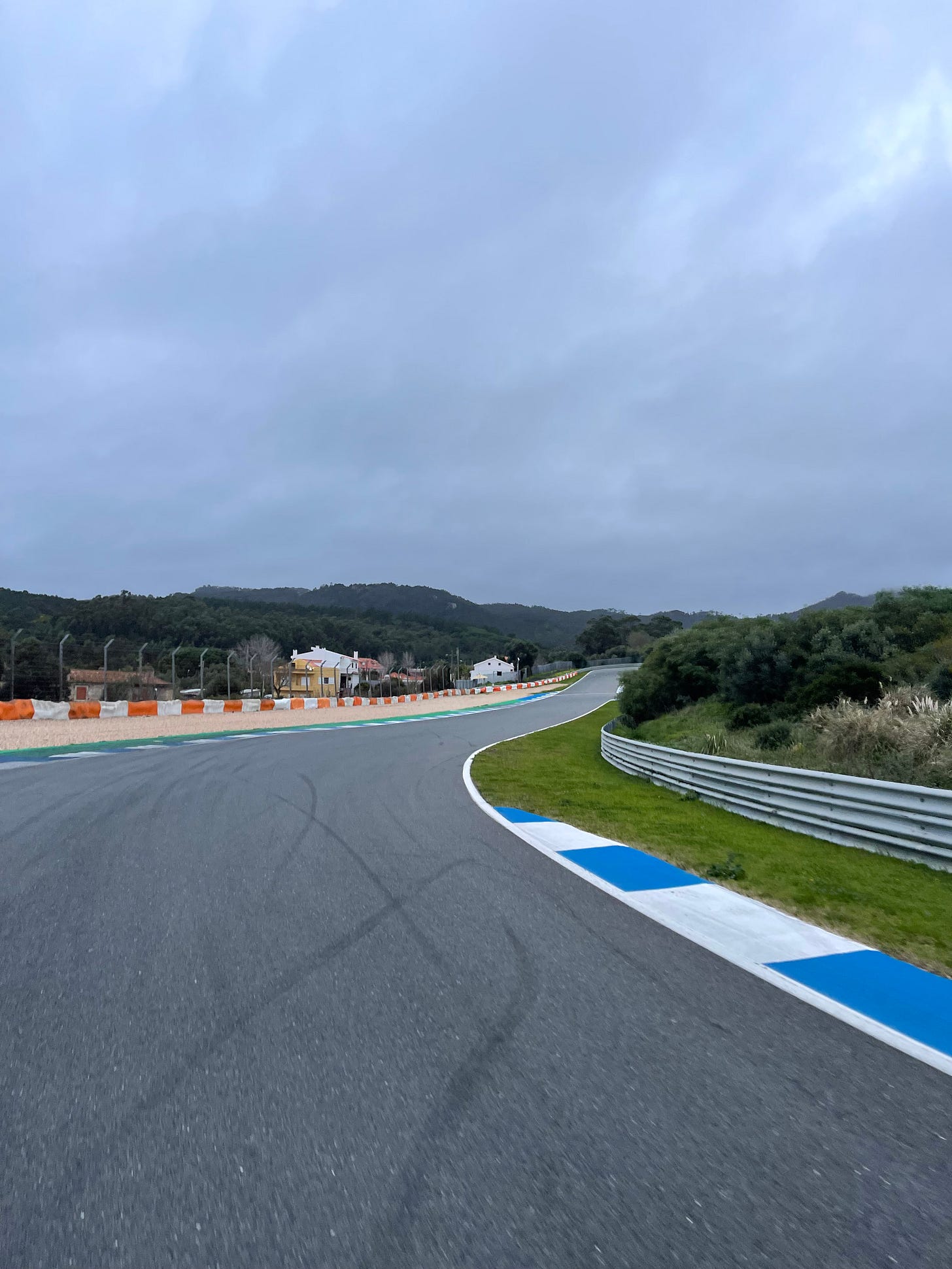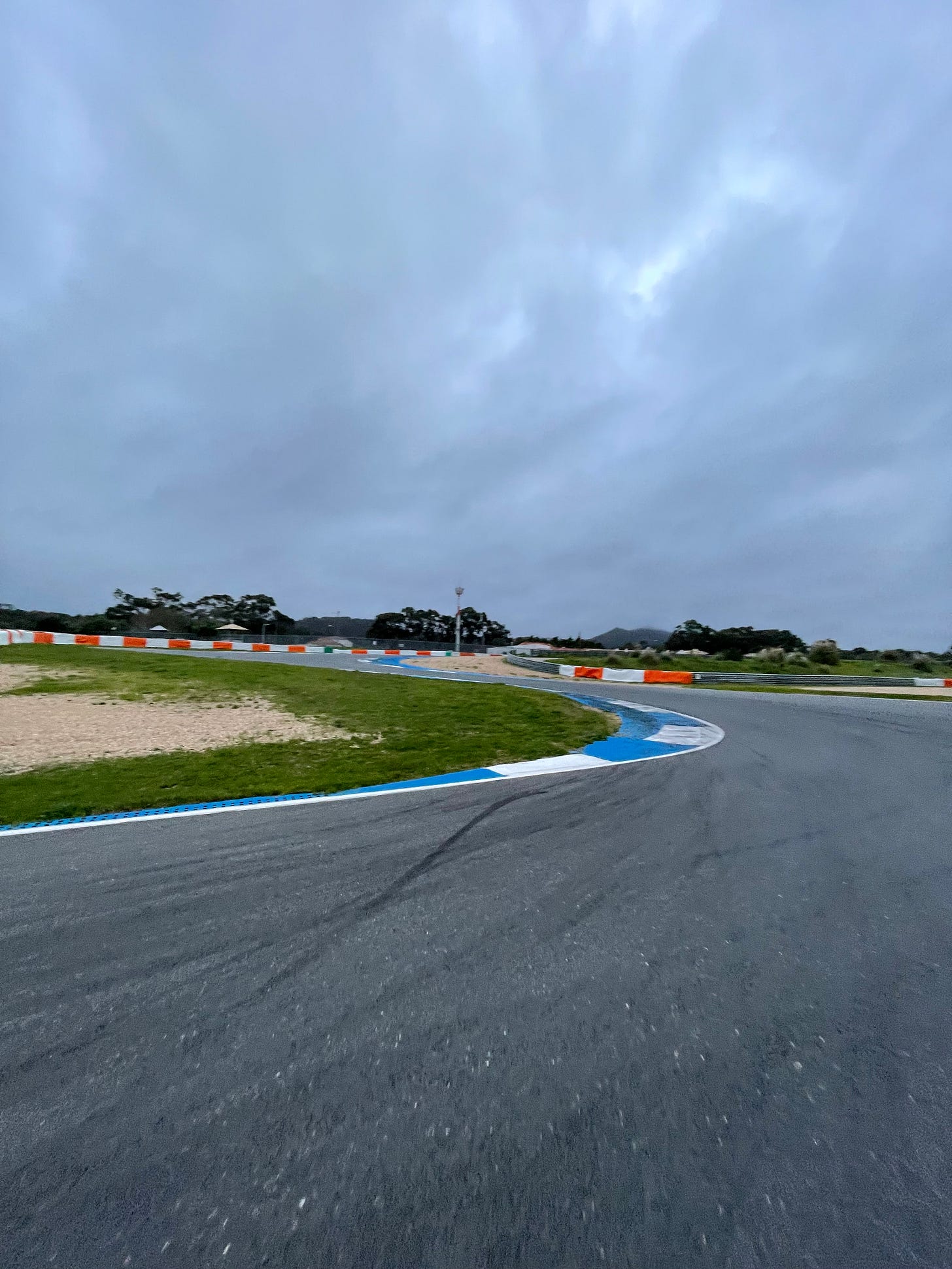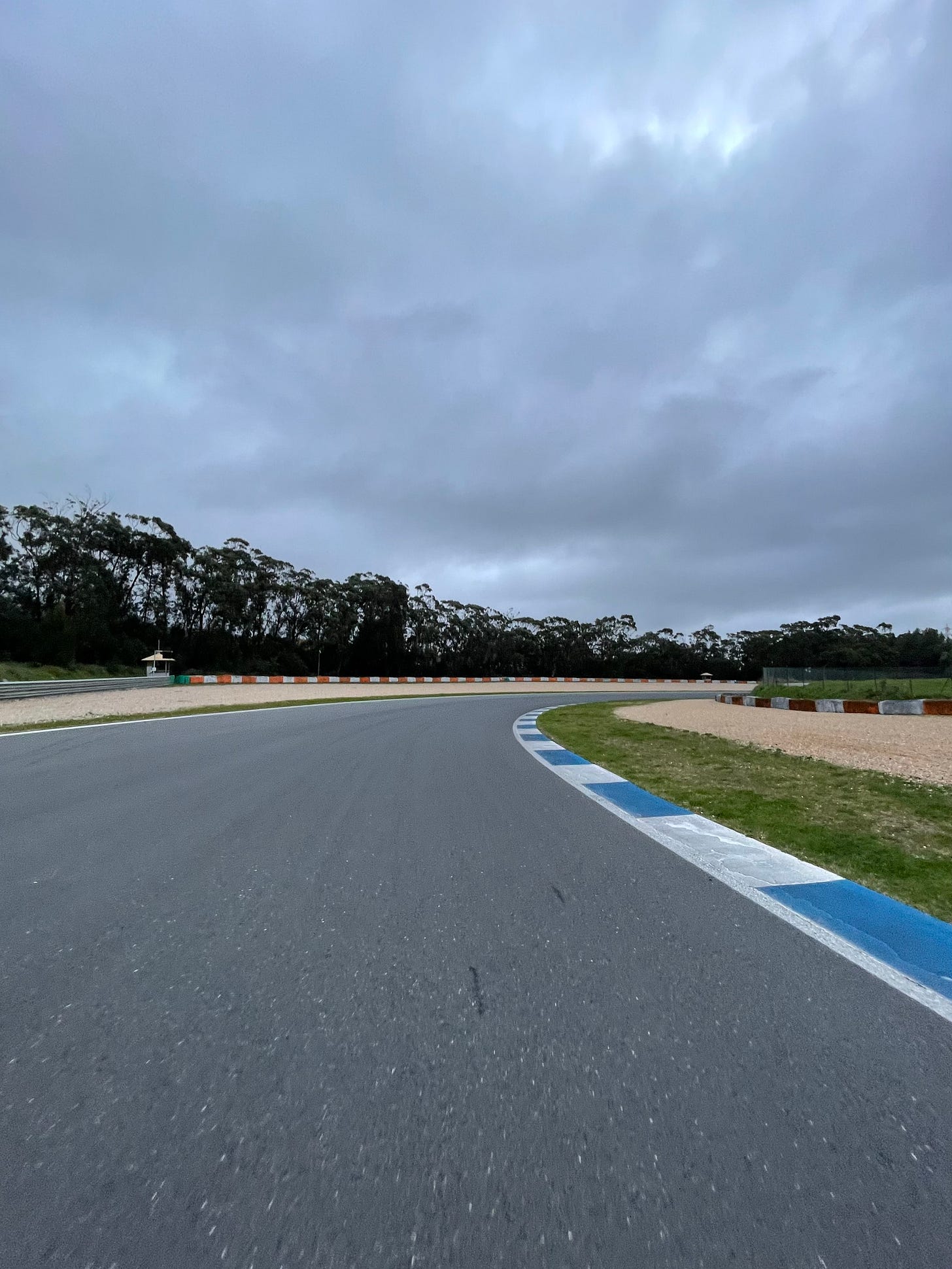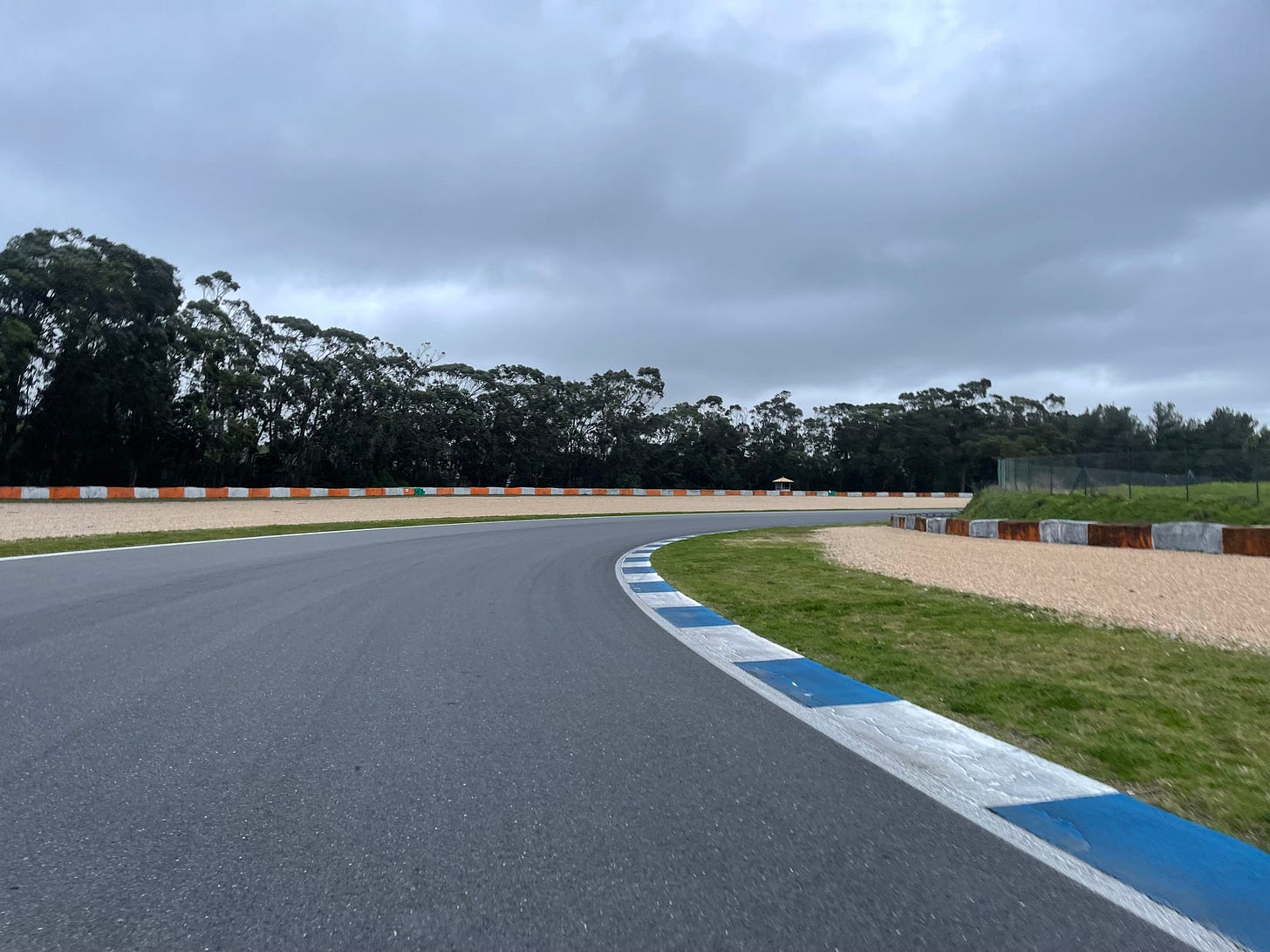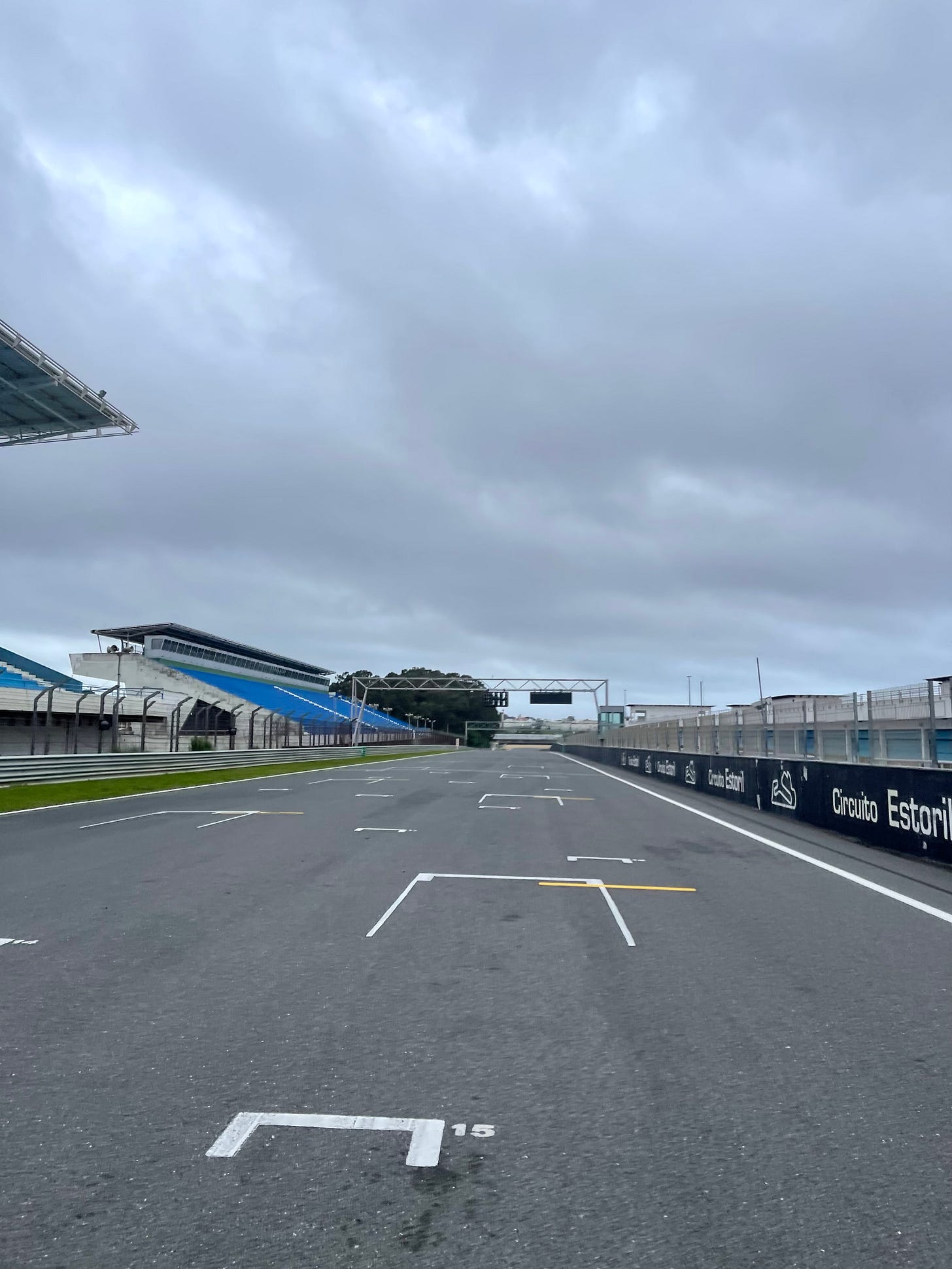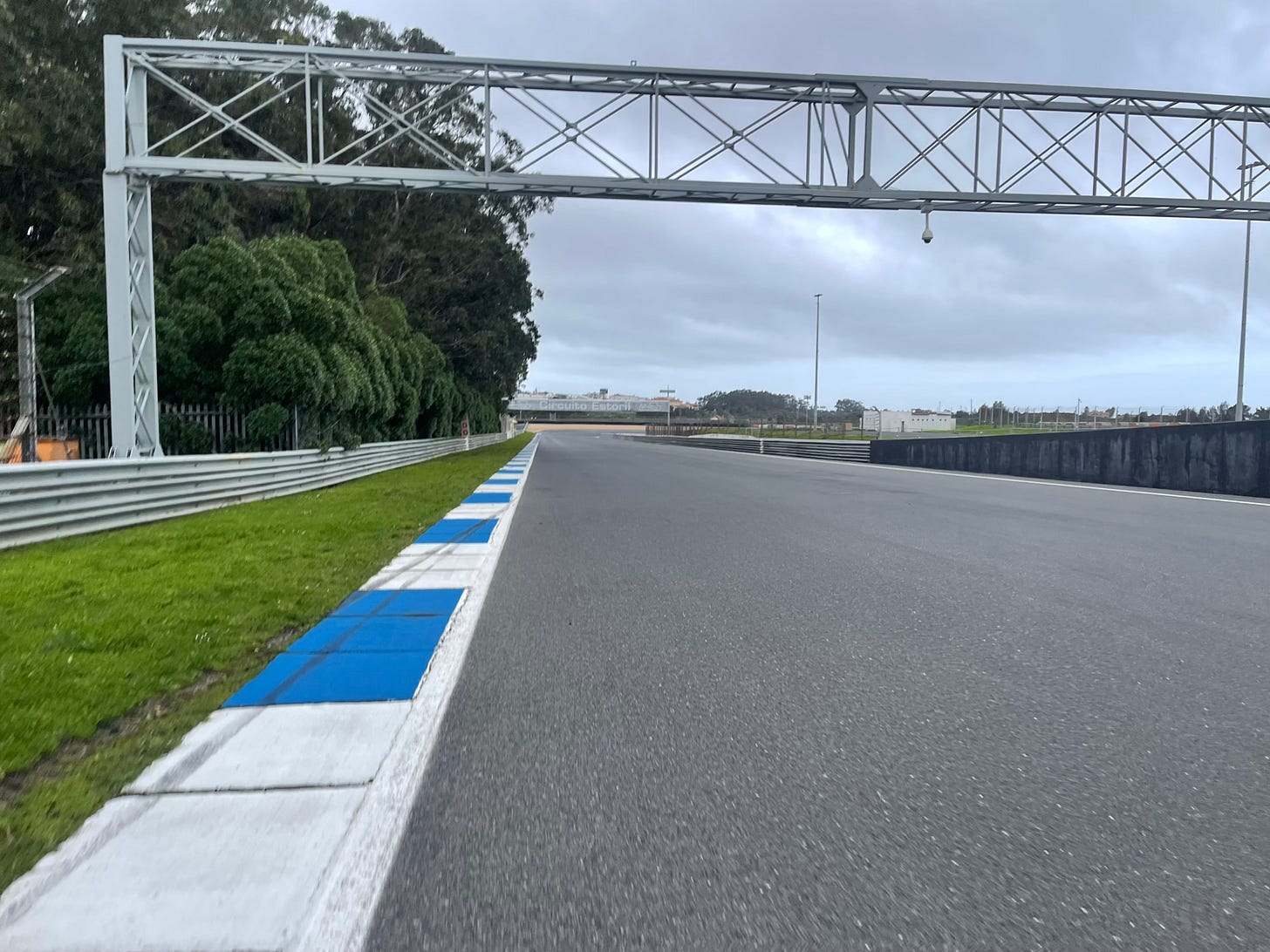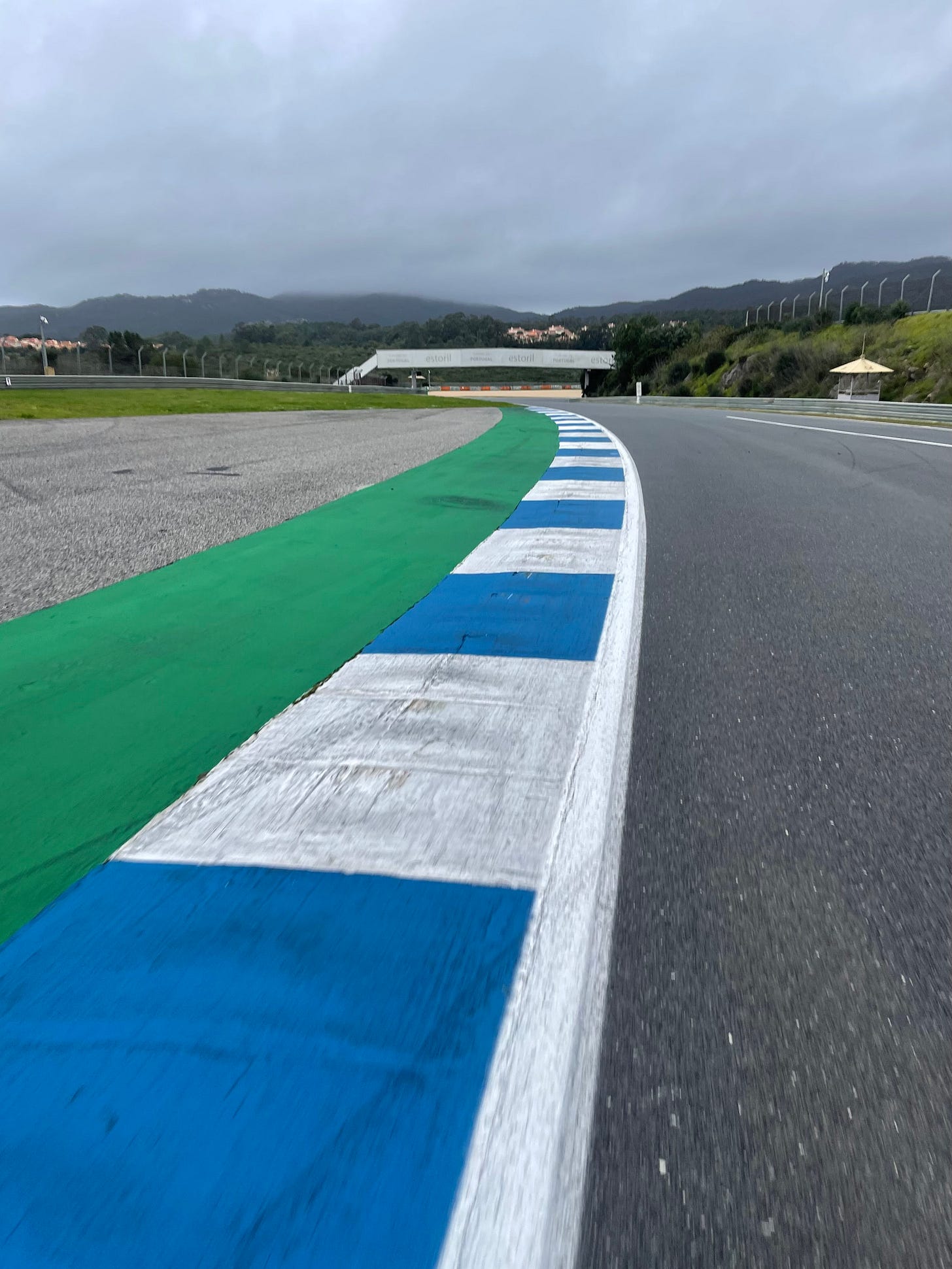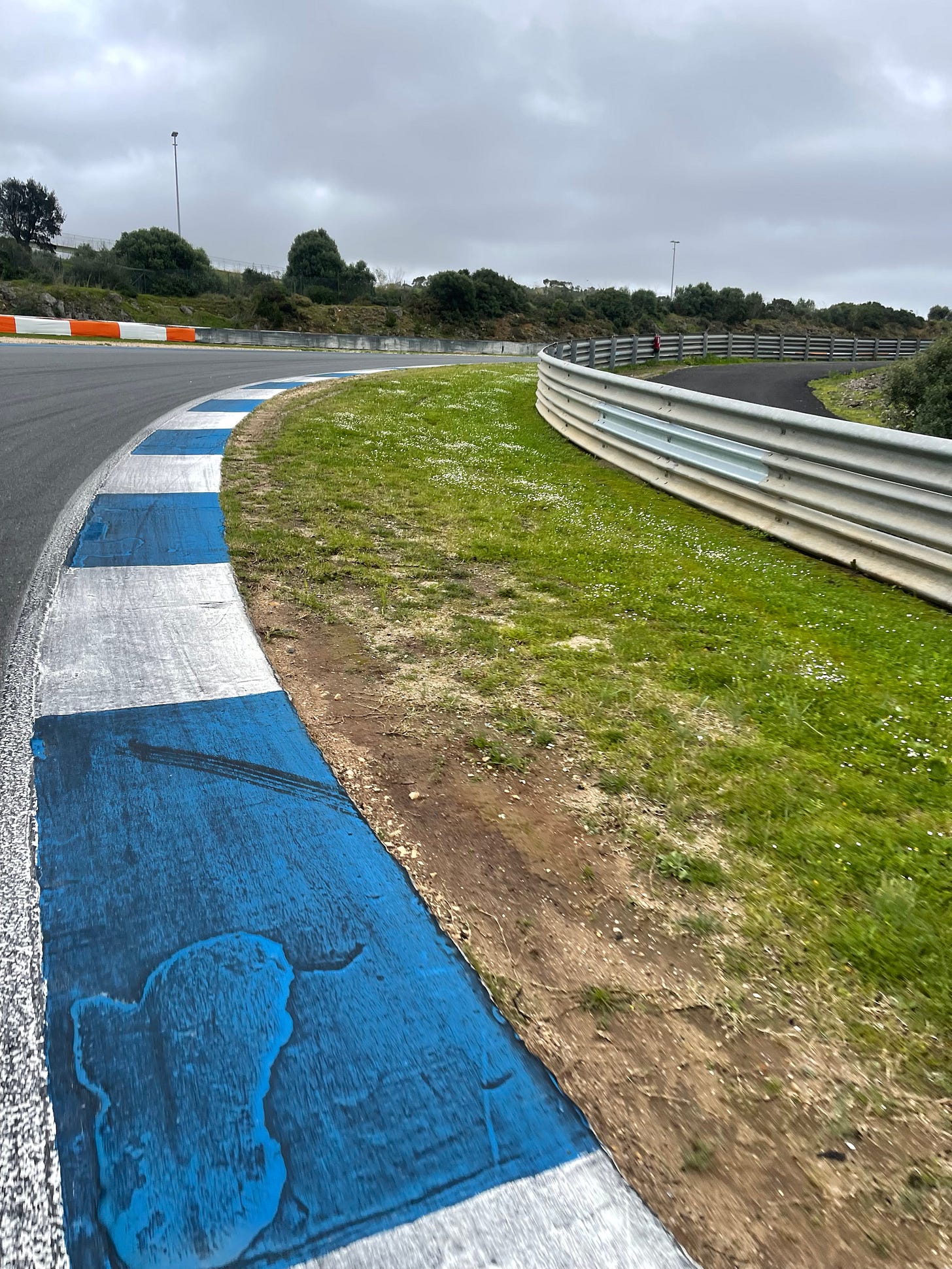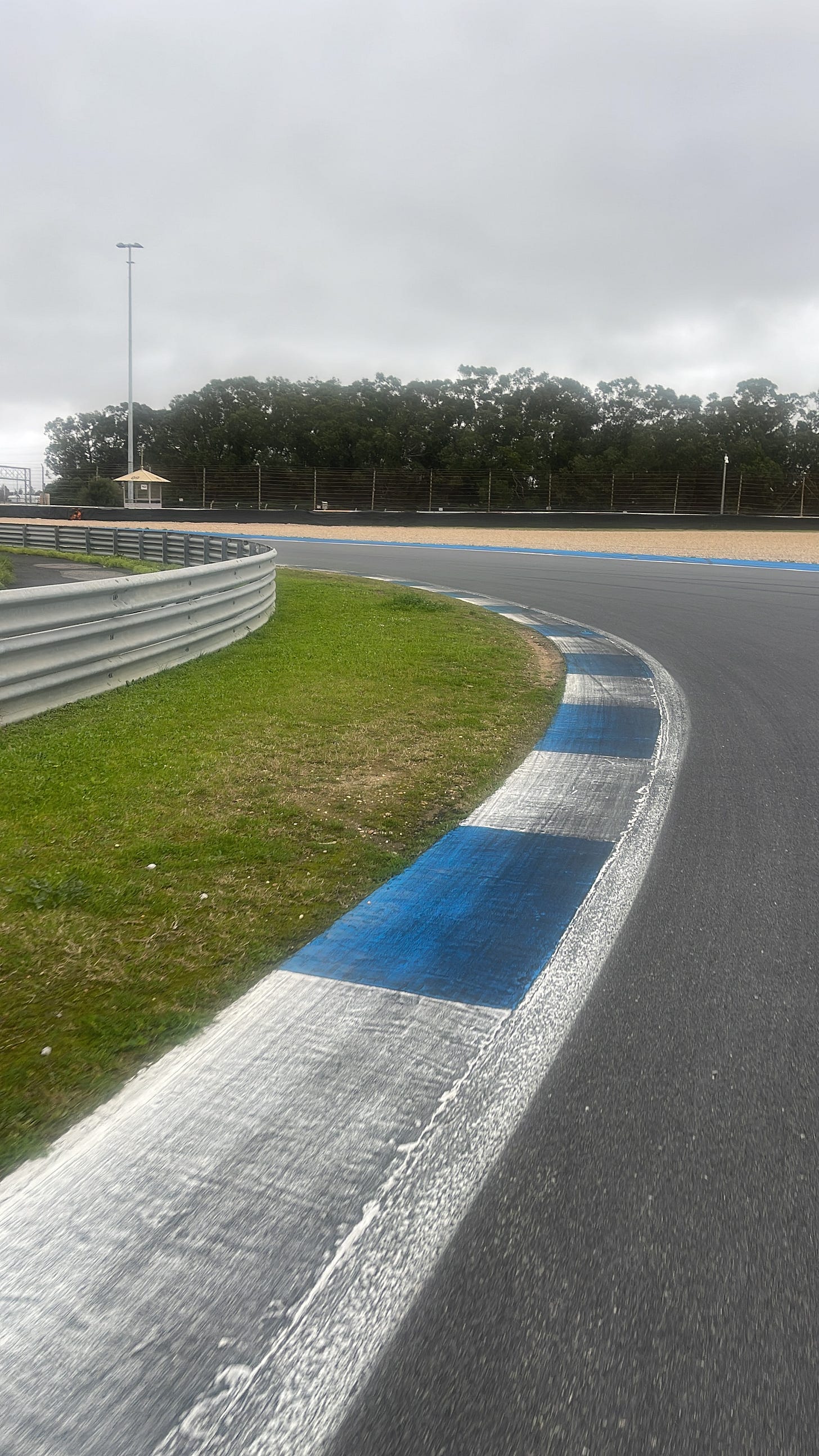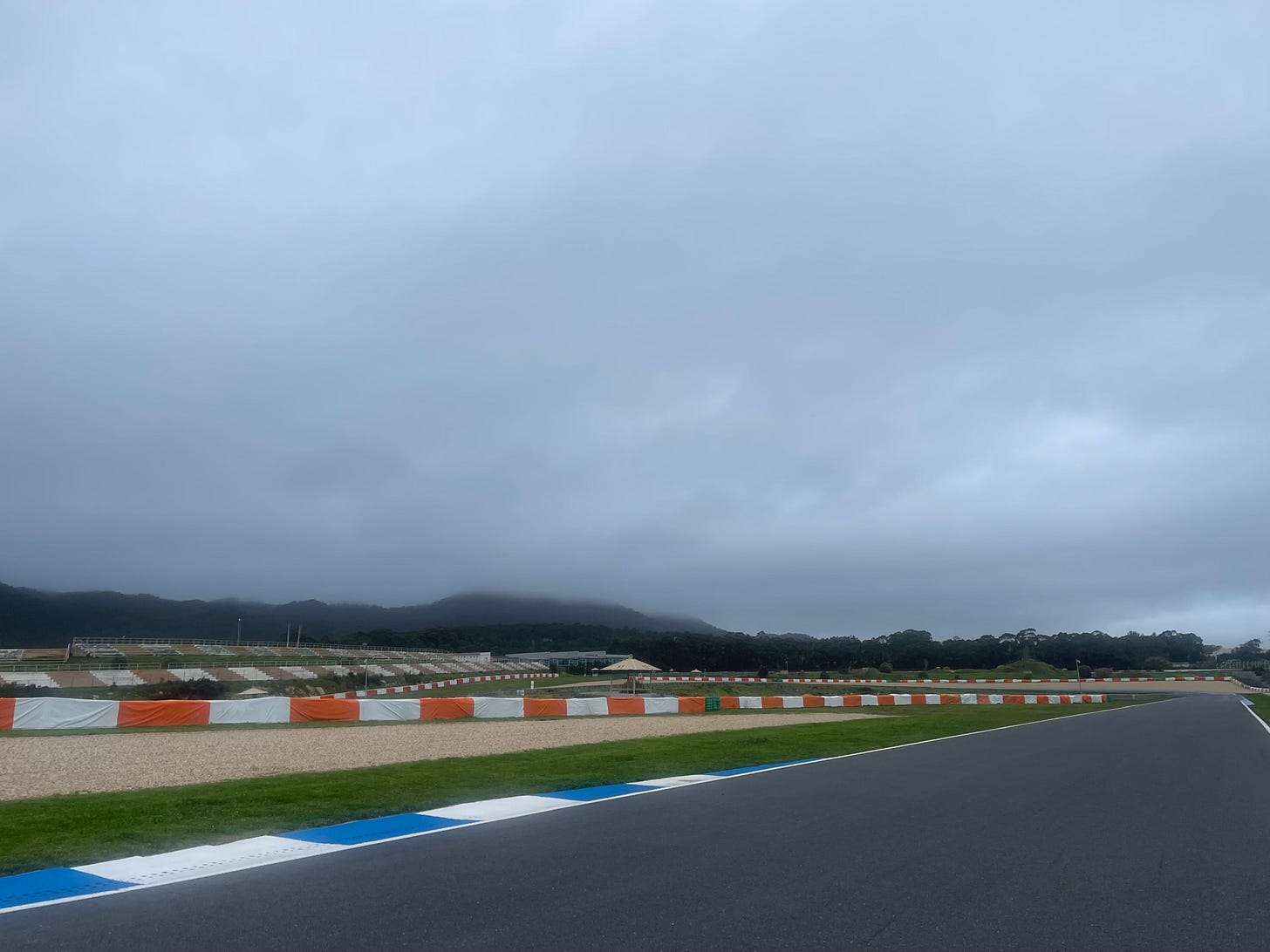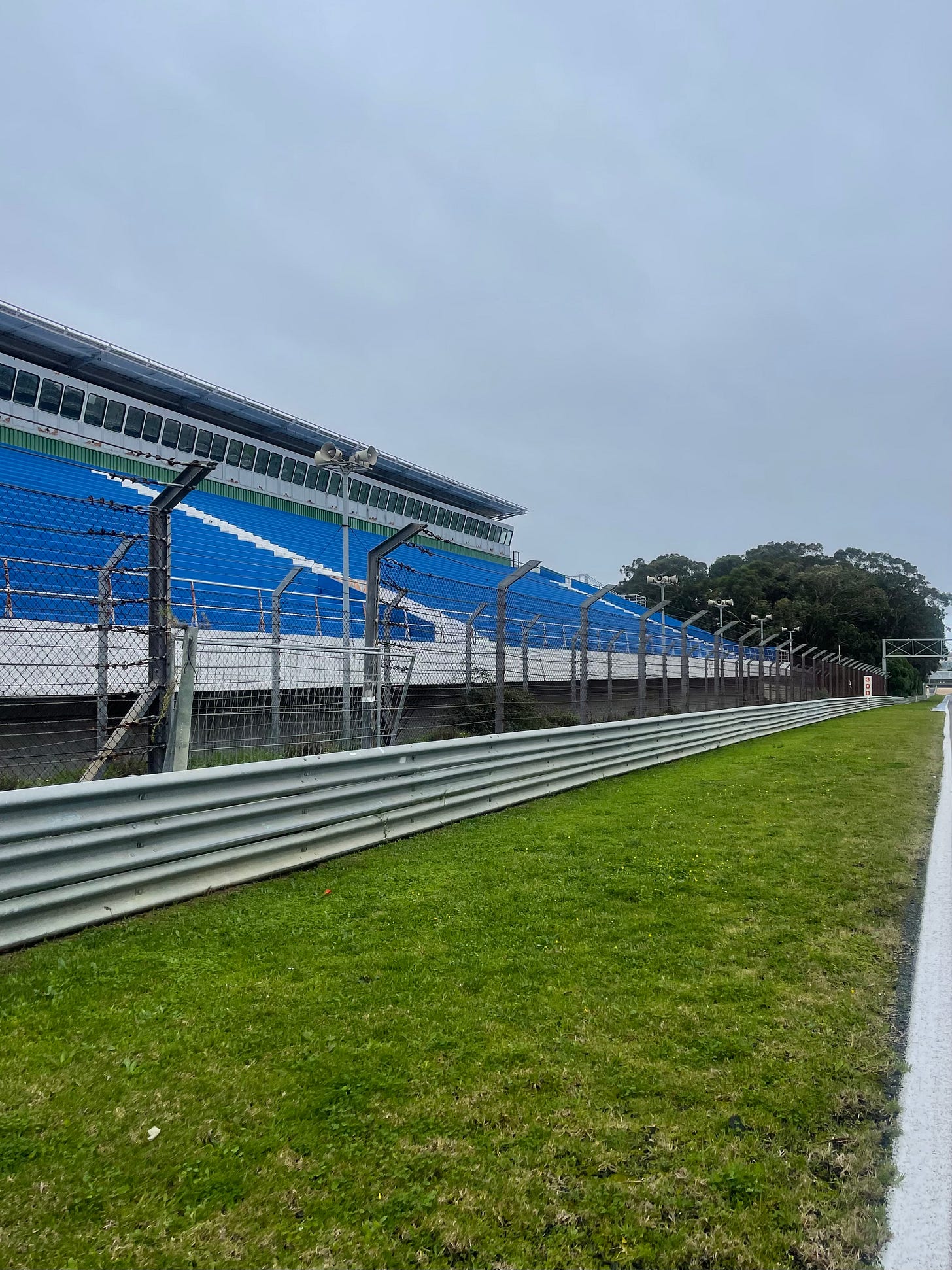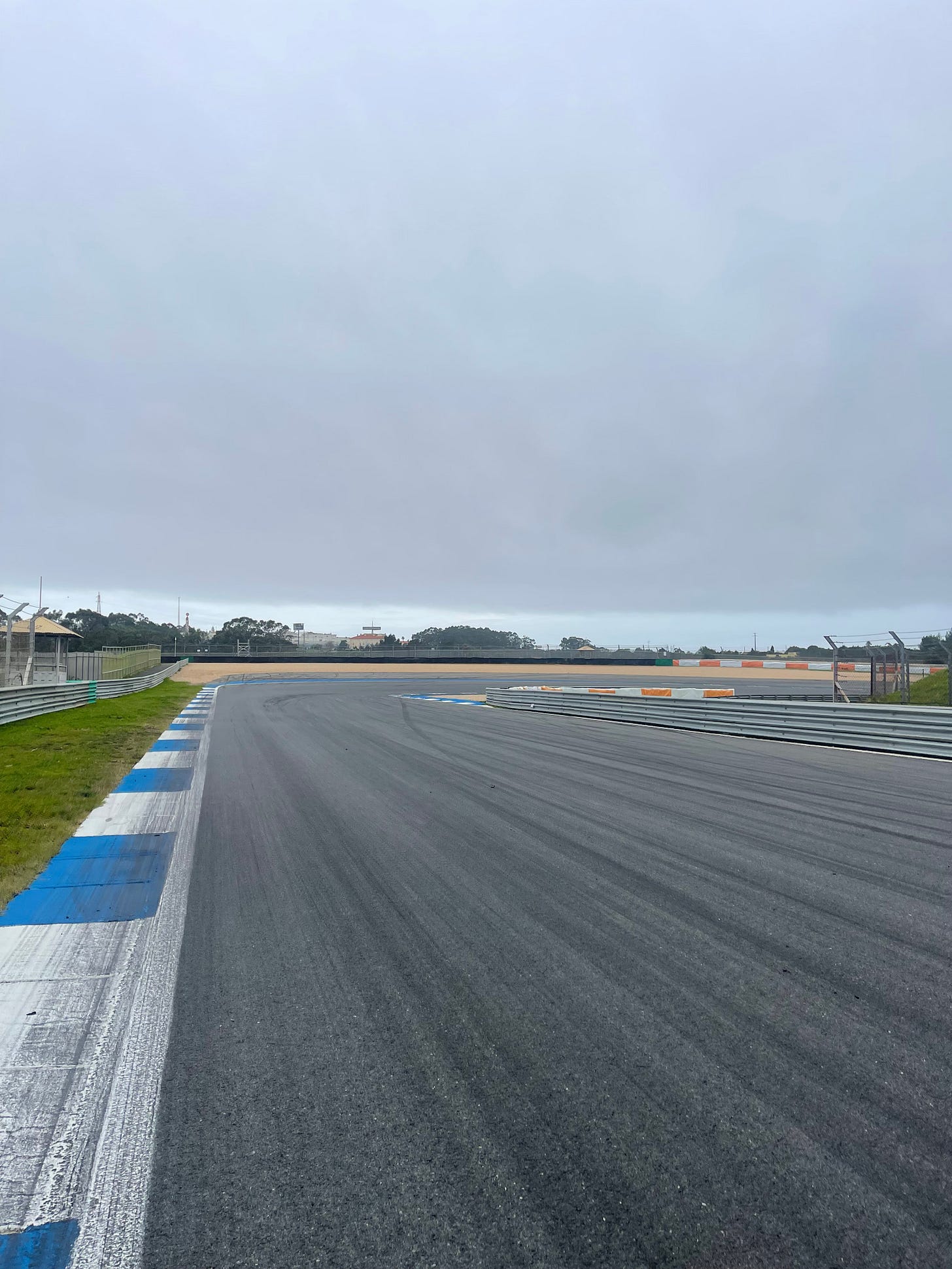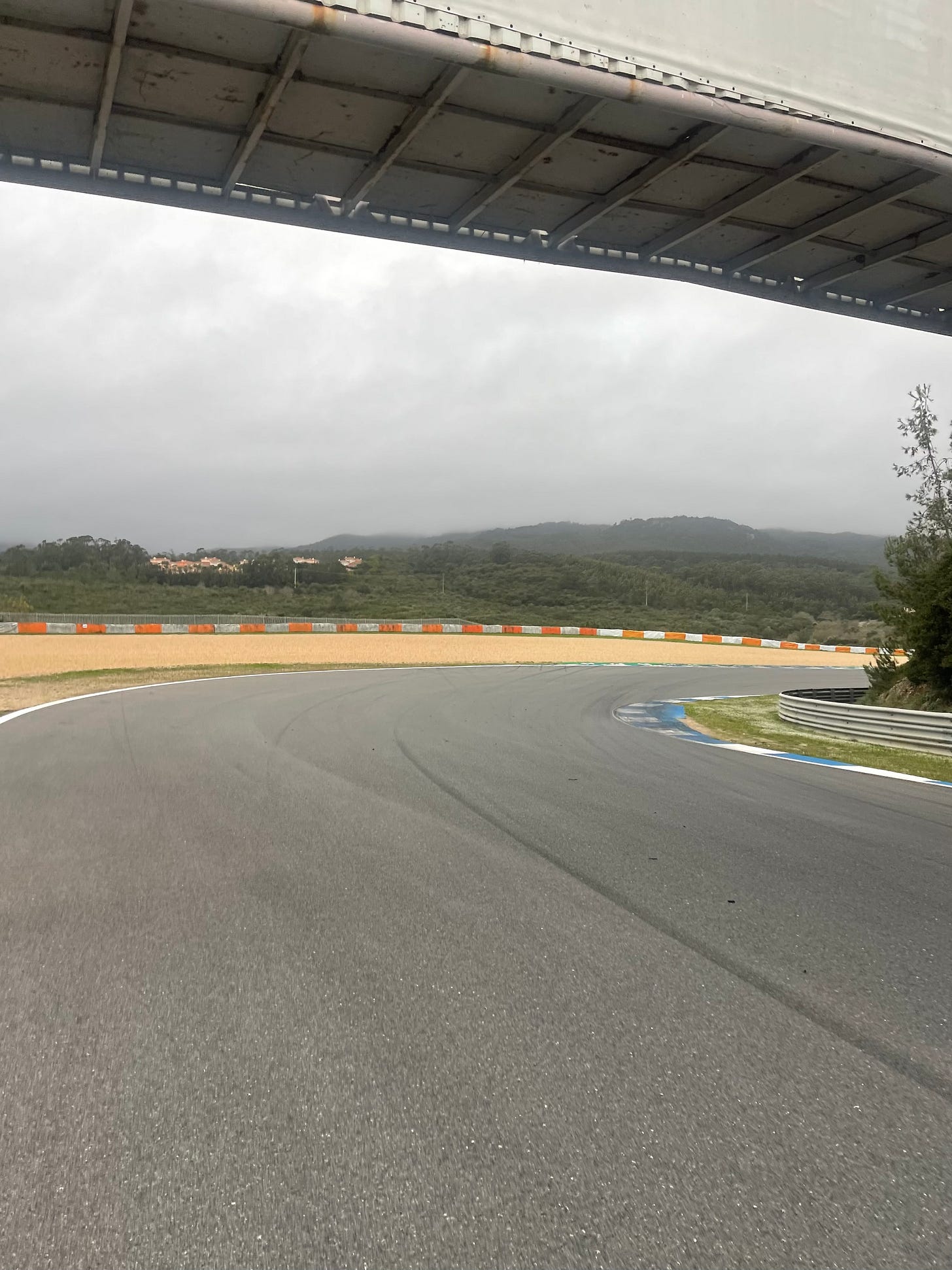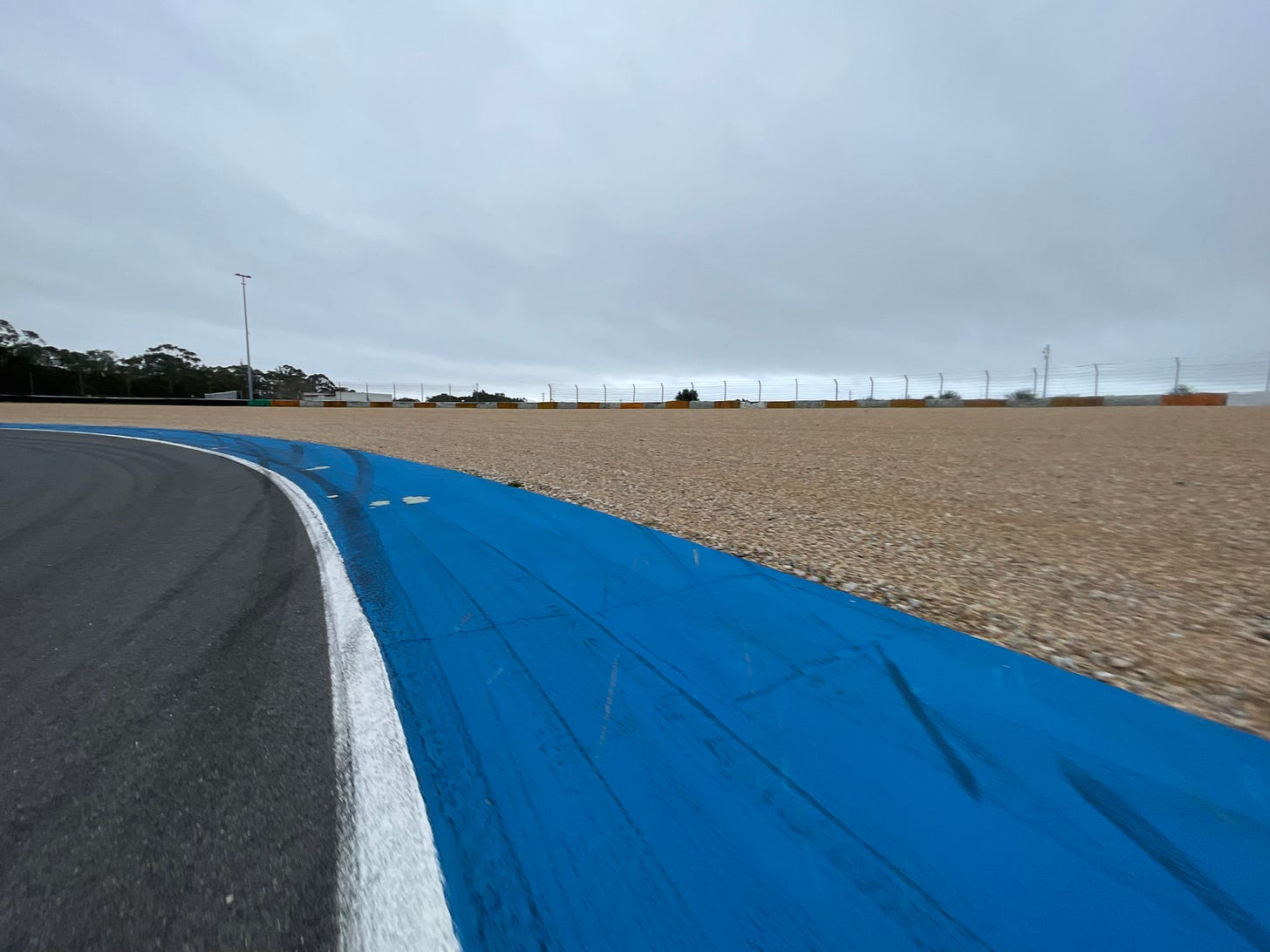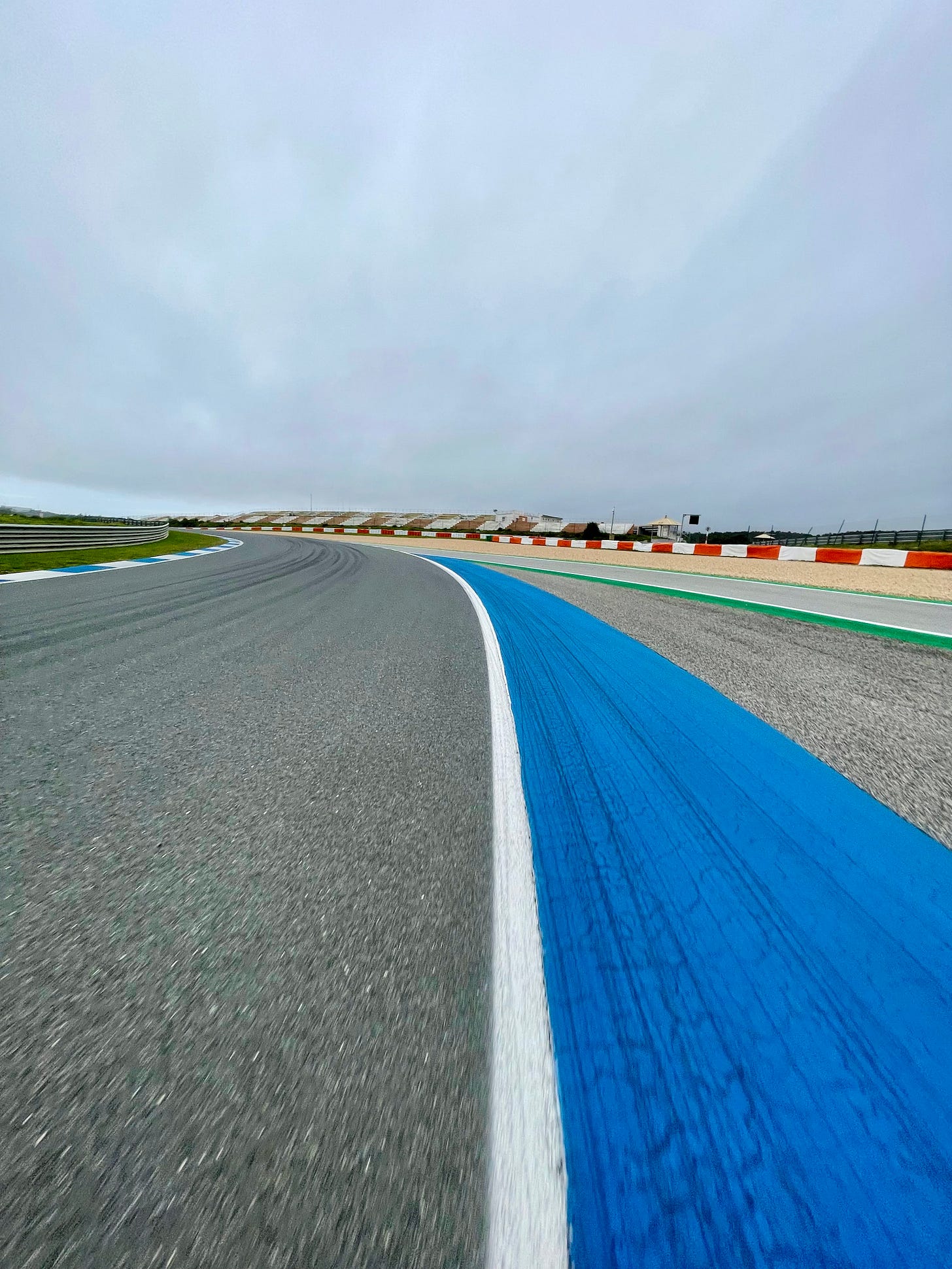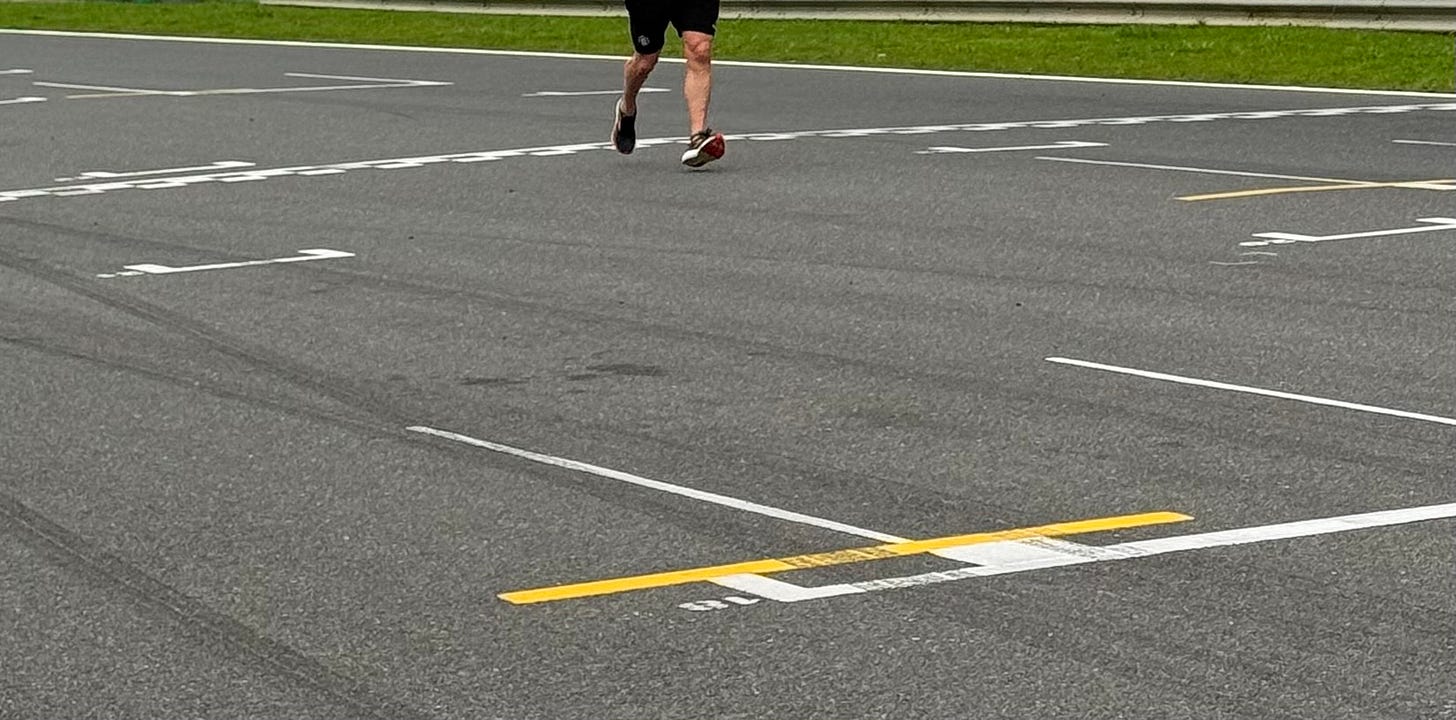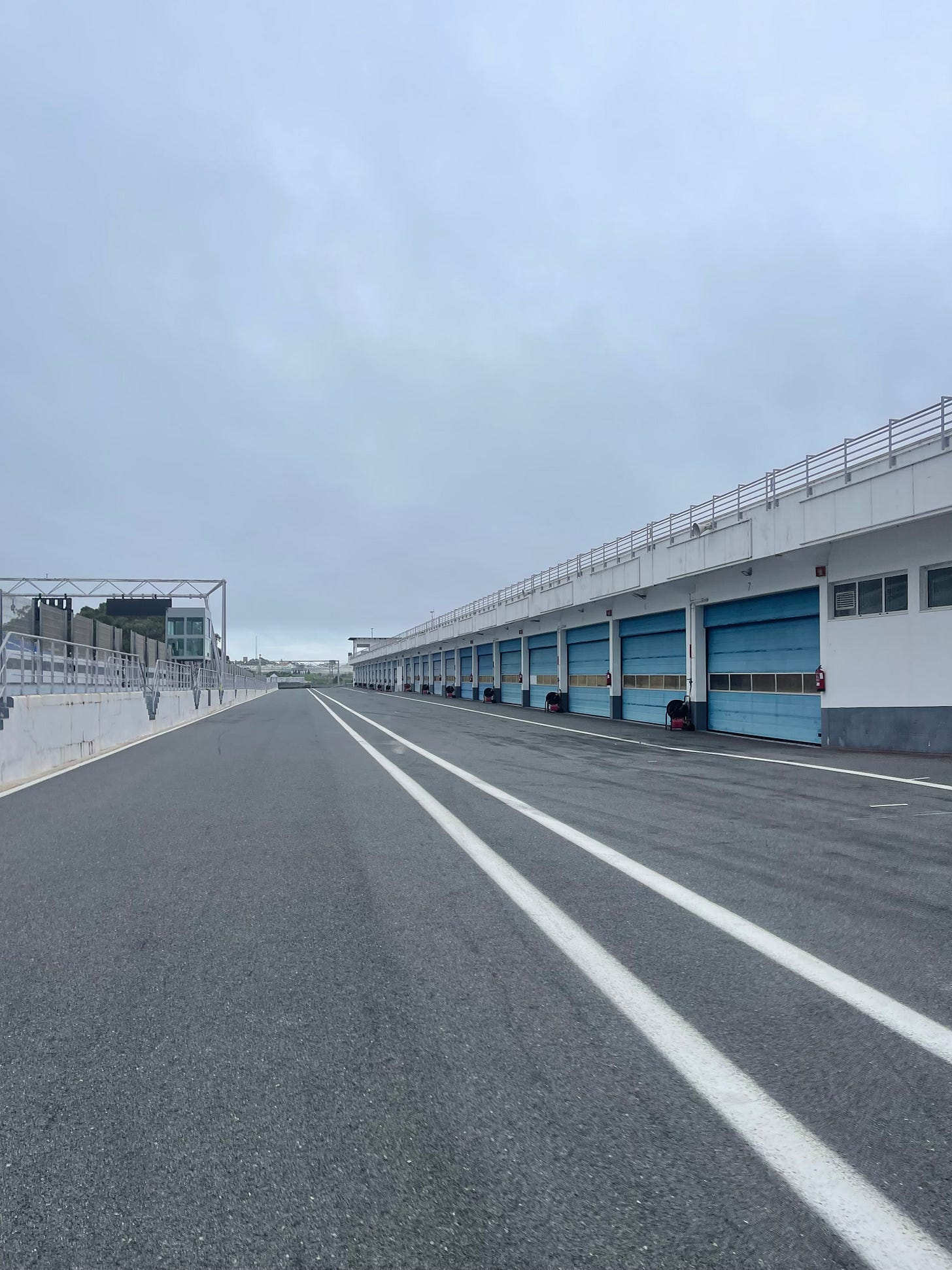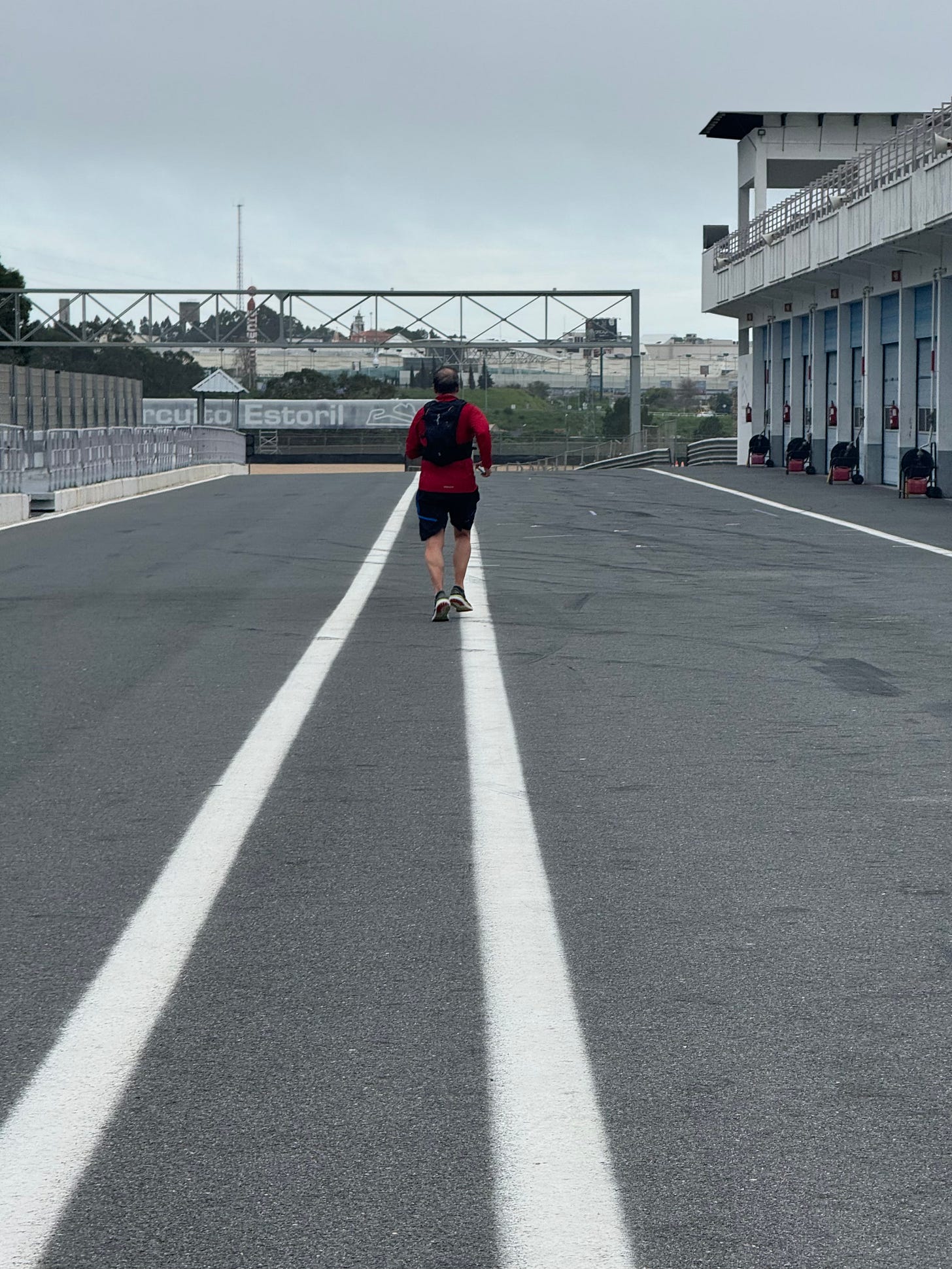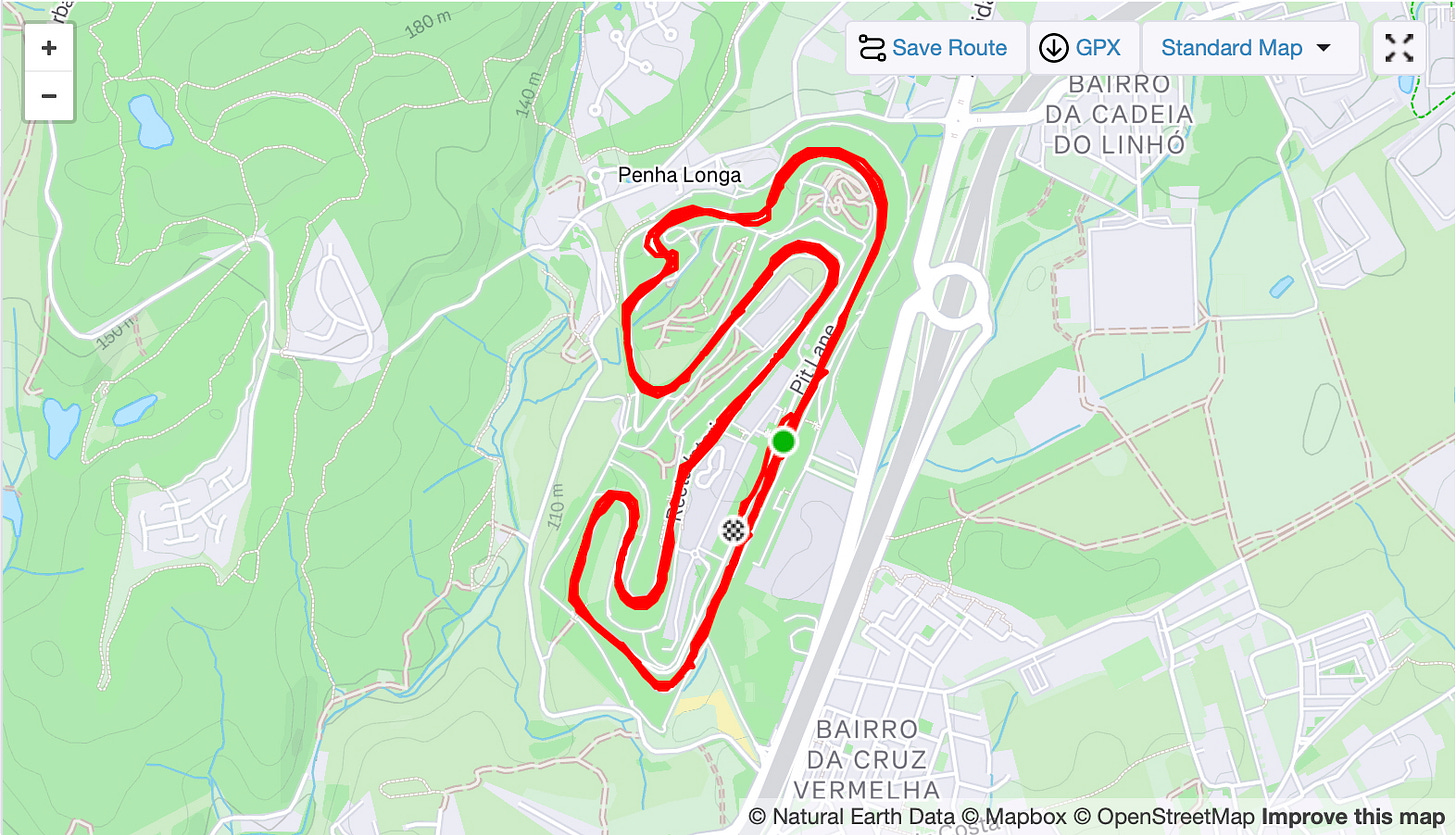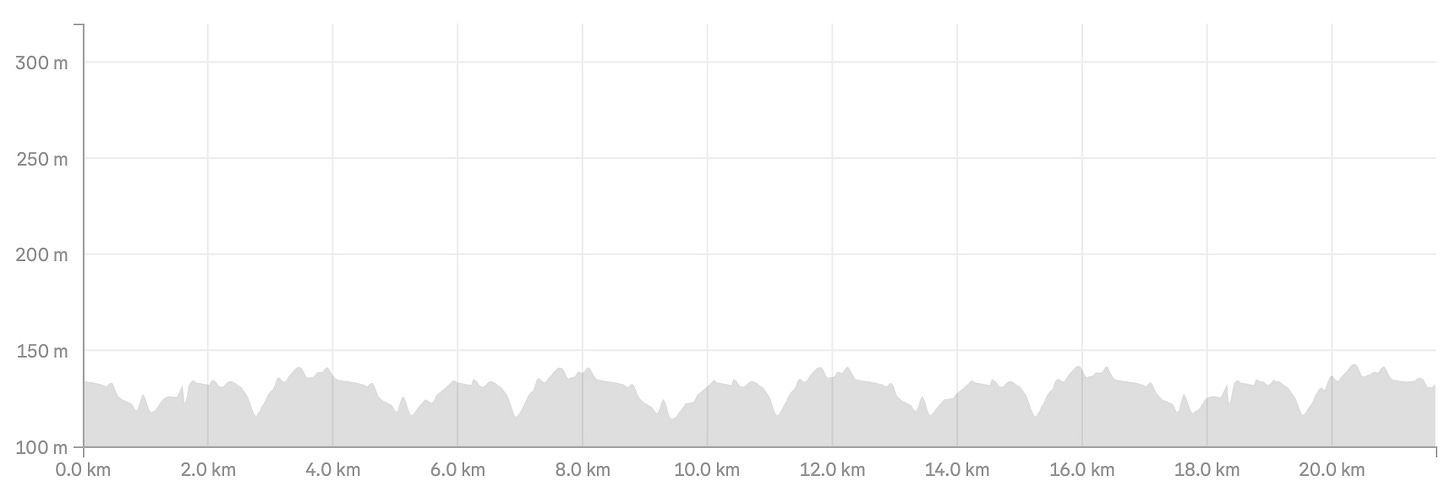January 26, 2025 at 7:18 AM · Cascais, Lisbon
The forecast for the race weekend had rain coming in at around 9 AM on Sunday, right in the middle of the race. The green light on the starting grid was to happen by dawn, around 7:15 AM. I live nearby, and needless to say I was wide awake way before the due time, unable to sleep with the excitement of the opportunity to race in the Estoril Circuit. It was still dark when I arrived at the paddock entrance and surprised security, who knew I was coming, with my early arrival. I was greeted by an extremely nice security guard who naturally questioned me about why on Earth was I arriving that early, during the middle of the night, to go and run a few laps, on foot, around the Estoril Circuit. After a few good laughs he directed me to parking behind the pit lane.
I was free to start my run whenever I was ready, with the Estoril Circuit empty just for me. Unbelievable privilege that I can't thank enough the Estoril Circuit team for their kindness. All my interactions were with genuinely nice people.
I have been to the Estoril Circuit for many different reasons, but the Formula 1 races that were held from 1984 through 1996 are forever stored in my memories.
These were the days of many F1 legends that I closely followed with my father and friends. I was lucky enough to be able to go to Estoril and see Alain Prost, Ayrton Senna, Nelson Piquet, Niki Lauda, Nigel Mansell, Michael Schumacher and many other fantastic drivers.
What an incredible feeling to jump on the track and proceed to the pole position for the green light.
Getting to the pole position
I am greeted by the empty stands and pit lane, the sound of silence, and a pinkish sky announcing the sunrise, a spectacular welcome to start my race. The temperature is at the perfection point and with a little bit of luck I will not need to change to rain tires in the middle of the race. It's still too dark, and Formula 1 cars do not have headlights, I could not get a single clean shot during my first lap. Between the slow shutter of my phone and the trepidation of my chassis during the high G-force turns, all was wonderfully blurred.
The best lap was set by Damon Hill in 1993 @ 1:14.859. With a total length of 4.349 km, it would be hard for me to match that.
End of lap 1
One lap's length is already a good training session for a casual runner. As I entered the main straight at the end of the 1st lap, the light had accelerated to cruising speed. I was ready to document my initial reconnaissance. On the night before I had been watching footage from previous F1 races in Estoril. I wanted to make sure I memorized the perfect trajectories used by the best drivers to mimic during my route. Of course, I had also to watch Ayrton Senna's unrivaled laps during rain sessions. If it was to start raining, I would be forced into the pit lane and adjust my laps to the Senna trajectory.
Even though I had already run, and even driven in Estoril, it always impresses me how wide the road is. At the end of the day there was no need for a lot of memorization of the perfect trajectories. The rubber from the tires on the track clearly marks the way.
The main straight is close to 1km long and that allowed the cars to reach amazing top speeds, close to 325 km/h (202 mph). If this is not impressive enough, the braking into the first turn is out of this world. It's an extremely tight right turn, descending. I first came to see an F1 race in 1987 and was seating on turn 1 (the cheapest tickets you could get back then). Right on the 1st lap, Alboreto and Piquet collided right in front of me. It's always a lot scarier when you see things live. There are real human beings in flesh and bone right in front of you, and their life is in danger. Your heart races differently, unlike when you are watching it on TV. All was well and the race was stopped.
Evidently, I was making engine noises, laughing like a child, as I accelerated on the 1st lap after the green light. And, since I got to the turn entrance at the neck breaking speed of 12.68 km/h I had to use all my braking power to attack the 1st turn. I did not want to end up like Piquet on the gravel.
Turn 1
Slightly skidding from excitement, I exit turn 1 and am surprised by the descent to turn 2. It's not easy to understand how irregular the terrain is on TV. Sometimes all looks flat, and Estoril is far from that. I knew that, but I also knew that wrong. It's a lot more irregular than I remembered. After all, we are right at the base of my sweet Serra de Sintra mountain range. It's a pity that it is overcast. Usually, the contrast pulled from the sun out of the green foliage blends perfectly with a bright blue sky. The footage from helicopter cameras during Estoril races was always beautiful.
Just before turn 3
We keep descending after turn 2, facing north with Sintra always on the background. I had reasonably strong, unusual south winds, on the main straight, but after turn 2 it was dead silent to the point where it was a little confusing. In a split second, we arrive at the sharp turn 3 and, facing south, we have almost 300 meters climbing at 4%. I was not expecting that. At the end of the climb we get to turn 4 which is just as sharp as turn 3. Luckily, I get there at a slower speed from the climb, and the chance of hitting the gravel is much lower.
Looking at turn 5 done at full speed into the interior straight
It's now pedal to the metal as we exit turn 4, an interior straight slightly bent by turn 5 which barely scratches the car acceleration. It's nuts and for the brave. The surprise, again, is that it looks flat on TV but is very slightly going up. Once again we hit a respectable top speed at the end of the interior straight. We are almost parallel to the main straight and have almost no wind. It boggles my mind and I am sure that it has to have a non-negligible impact on the real car behaviour.
It's time again to use my neck breaking brakes to face the interior parabolic turn 6.
Interior parabolic
Thankfully, my rigorous training has me well prepared to face the 0.04 G turn back to the south (yes, I did the maths). Compare that with the up to 6G that modern cars are capable of. As we leave turn 6, we have what used to be called E-Stand, where I watched several F1 races over the years.
E Stand
We are now on a steep descent into turn 7, hitting up to 10% grade and I can't even begin to imagine the rush of adrenaline while attacking this turn in a F1 car.
Turn 7, a lot steeper than it looks
After playing with the laws of physics we are now field testing my 1st law of running. What goes down, has to come back up. We are facing a climb of progressively increasing grade for the next 800 meters. Strava registers it hitting 12%; I have no reasons to doubt it. I had to fire all my cylinders.
Coming out of the turn 7 with turn 8 at a distance
This is the slowest section of the circuit. I have to be careful with the acceleration coming out of the turns, trying not to spin from my excessive horsepower. The climb is tough. It's difficult to maintain the proper mental perspective during the run.
The beautiful climbing chicane of turns 9 and 10
I am running, on foot, but in my mind, I am viewing F1 cars driving fast through these turns as I try to follow what would be their trajectories. My body is moving at its speed while my mind is wondering on another planet. It makes my progress seem effortless while also taking forever to complete each section. A fun paradox.
Enter the parabolic turn, renamed to Parabólica Ayrton Senna. Roughly a 180 degrees turn with 100 meter radius driven at an unimaginable speed. My G-force is reduced to 0.009G, pitiful.
Parabolic turn
Parabolic turn
It's now time to cross the finish line for lap 2. Still with empty stands, now with a lot more light, unfortunately without the sun that I had longed for. I wish I could say that I was flooring it through the main straight. The mental weight of doing 1 km running compared to driving it above 300 km/h is working against my strengths. There is no contest in this man against machine race.
Lap 2
I run closer to the pit lane to check if my team members have any information on the pit boards. Back then, drivers had somehow to be able to read information on these pit board while flying by close to 300 km/h. That is a testament to the extraordinary capabilities of an F1 driver.
Lap 2
I remember that almost 30 years ago (hard to swallow),I was asked about what object would I choose to be placed in a museum to represent the then-present state of human evolution. The correct answer should have been something like a book about the International Bill of Human Rights. Regrettably, still today, I don't think we got that one right, nor have abided by it.
Approach to turn 1
As I tackle, once again, turn 1, I remember having elected a car, specifically a German BMW car, as my item of choice to represent the state of human technological evolution (as an engineer, I was biased).
Turn 1
I stand by my choice back then, and even more so today, while not necessarily a BMW (but that also still stands). A car is an incredibly reliable machine, with predictable behaviour and fantastic maneuverability. We can control how it accelerates, how it brakes, turn the wheel, and have it follow infinite variations of road conditions. And doing it to us, has become second nature. The roads do not need to be perfect smooth, no rails are required. They operate in extreme weather conditions, and most of the time we turn the key (or used to turn the key) they magically start and go.
We are diving into turn 2.
Exiting turn 1 with turn 2 in sight_
Cars use some of the most advanced materials and composites, have extraordinary computing power, communications, all kinds of sensors, climatization, air filters, electrical generators, navigation capabilities and so many other technological advancements that we have taken for granted. Above all, they just run and make climbs, like the one battering me on turn 3, look like are easy descents.
Turn 3, using all the track
If you have not read the book "Thinking in Systems" by Donella H. Meadows, I highly recommend that you do so.
The Formula 1 circus is a complex competitive system that has pushed many technologies forward. (I hope Donella would have forgiven me for the superficial analogy).
There is a regulator that sets the rules and keeps adjusting them to tune the championship interest gauge. There is also a controlling body that makes sure the teams and drivers follow the rules.
Turn before interior straight
The teams and the drivers are always pushing the rules to their limits, sometimes bending them, and not too infrequently breaking them surreptitiously, hoping not to get caught, even bluntly cheating sometimes.
The lack of wind in the interior straight puzzles me. I keep progressing at a consistent pace. Laps have just the right length to make it interesting even if I am going around and around.
Interior straight, arriving at the interior parabolic
Teams operate on the leading edge of composite materials, computing, and sensors to fully optimize combustion, and use aerodynamic tricks to speed up or brake the car. We don't want any team to have the monopoly for too long because it will kill the interest from spectators and reduce the inflow of cash. A delicate balance that everyone wants to break but not too much.
If I take pride and joy in the solitude of my runs, F1 is on the total opposite pole. They need TV audiences to survive (even if TV audience nowadays has a much broader meaning than it used to, it is still the glue that holds together the sport. An iPhone or an iPad can be seen as a TV too).
Lap 4, the TV booths that keep sports alive
But not all races need to be at F1 level. There are many niches that, in one way or another, also help pushing technology forward.
Race car purists frown upon electric car races and I understand. I too remember well the distinctive scent of the F1 fuel. I too remember the deafening sound of the engines that I could not bear without covering my ears. The pounding vibrations on the chest from the impressive engine power that pulled me right into the middle of the track.
My approach photo on turn 1 never gets old. The rubber marks on the asphalt make it look like I was running at the speed of sound.
Fantastic turn 1
I remember the cheering of the crowds, during the golden days of F1, "my" golden days, that seem to have returned.
Racing, as running, does not have to all be at F1 level to be fun and important. I am having a roaring fun, alone with no spectators, running at an amateur pace.
Cars have been pivotal in the advancement of progress, and will remain so, even if there is expected to be a paradigm change. It is becoming evident that they will be driving themselves.
Turn 2, going underneath the passage to the more affordable stands
It's hard to swallow, but autonomous cars will become better drivers than we are. It is mandatory that they do so. The number of road deaths that will be prevented demands so. The rationalization of natural resources also demands so. We need it to happen to prevent the blockage of our cities
I had planned that 5 laps would be the right length to complete my half marathon, but since I kept optimizing my trajectory, I identified on the final lap that it would be slightly short. That's when I decided to follow the most awkward possible trajectories trying to cover the most possible length.
I was pushing to the limits of the track but there was no chance in hell that I would crash. This had to go down in the records as a lesson for future autonomous vehicles.
Don't crash
The announced death of the individual car can be the pronounced rebirth of the raceway cults. If these have been under pressure from environmentalist movements, they are destined to survive as the only locations where humans will be able to show that they possess amazing driving skills. It will be a travel back to our roots, and the racing sports might become more attractive than ever.
Running on the edge of the track gave me a different perspective of the track; again, the road is extremely wide. It is very reassuring, seeing all the safety mechanisms that are in place, namely very wide gravel areas to slow down cars - an aside, I wonder why they are not used at the end of airport runways for the same intent.
The photo of the interior parabolic is as if I was leaning on a superbike with my knee touching the asphalt.
Interior parabolic at full speed facing the E Stand
It's a pity that I did not have the blue sky posing with the rest of the track. There are so many beautiful colors in the Estoril track.
Safe
I was surprised in my final attack of the main straight. Unaware, my wife had been given access and was waiting for me by the checkered flag spot. She shot my slow progress along the road as I came out of the parabolic at full speed. One km is a long distance and I only noticed that she was around as I was very close to the finish line.
Final approach
From her perspective it felt like it took me forever to finish that straight. Even with my wide trajectories, according to my Apple Watch I was still short on my target distance. This was the perfect excuse to perform a spin drift maneuver after crossing the finish line and heading back to the entrance of the pit lane.
Final approach
Flying over the finish line
The pit lane looks amazing, even if completely empty. I dutifully follow the maximum speed rules in order to maintain maximum safety. After all, I could not take any risks of running over my wife!
Getting into the pit lane
Revving the engines down
This was a fantastic race. There was only one car on the track but I lived through many years of intense Formula 1 watching in my mind.
May the Estoril Circuit be around many years for all the exciting advancements in the car and racing industry. Even if these advancements will take away the driving pleasure from us, Estoril will be around to remind us on how amazing it was.
We will have more time for running!
Enjoy your runs!
-APF
Elevation gain: 325 m / 1066 ft

